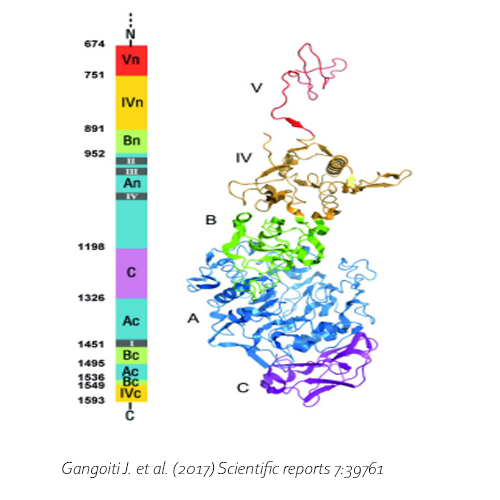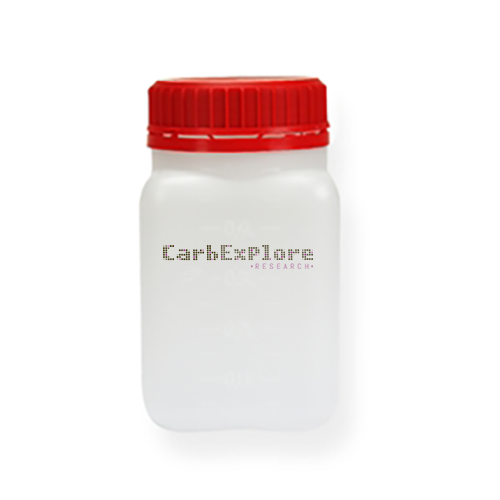-
The N-terminally truncated GtfB enzyme of Lactobacillus reuteri NCC 2613 is a member of the GH70 family. The 4,6-α-glucanotransferase converts amylose, amylopectine, potato starch, and malto-oligosaccharides with a degree of polymerization (DP) of 5 to 7 in a low molecular mass reuteran-like polymer containing 75 % α(1→4) and 25 % α(1→6) glucosidic linkages, and α(1→4,6) branching points. The Lactobacillus reuteri NCC 2613 enzyme possesses the Generally Recognized As Safe (GRAS) status, making it an interesting product for the food industry. There are a lot of differences between the products formed by the 4,6 glucanotransferase GtfB subfamily. GtfB strain 121 formes a long linear consecutive polymer with α(1→6) linkages (IMMP), whether the glucan of strain NCC 2613 is branched and has a low molecular weight.
This product is sold for research use only.
*Enzyme activity was determined by the iodine-staining assay using amylose as substrate. One unit of activity is defined as the amount of enzyme preparation converting 1 mg of substrate per min.
-
The GtfC enzyme of Exiguobacterium sibiricum 255-15 is a member of the GH70 family. This glucanotransferase is active on malto-oligosaccharides and starch, synthesizing isomalto/malto-oligosaccharides (IMMOs) containing 52 % α(1→6) and 35 % α(1→4)-glycosidic linkages using amylose V. Biochemically, GtfC enzymes are close related to the GH70 GtfB enzymes. Although its domain organization is more closely related to GH13 enzymes (α-amylases). Making the GtfC 4,6-glucanotransferase an interesting intermediate between α-amylase and glucansucrase enzymes.
This product is sold for research use only.
*Enzyme activity was determined by the iodine-staining assay using amylose as substrate. One unit of activity is defined as the amount of enzyme preparation converting 1 mg of substrate per min.
-
The GtfD enzyme of the gram-negative bacteria Azotobacter chroococcum is a unique evolutionary intermediate between glycoside hydrolase family GH13 (α-amylase) and GH70 (glucansucrase). The enzyme displays 4,6-α-glucanotransferase activity using malto-oligosaccharides (> DP 4), and starch. However, the enzyme is unable to synthesize consecutive α(1→6) glucosidic bonds. Instead it forms a high molecular mass α(1→4,6) branched reuteran like polymer with 68 % α(1→4), and 32 % α(1→6) glycosidic linkages using amylose V as substrate. The glucan is highly similar to the product formed by Lactobacillus reuteri GtfA glucansucrase from sucrose. The products formed by the GtfD enzyme is potentially useful for the conversion of starch in the food industry.
This product is sold for research use only.
*Enzyme activity was determined by the iodine-staining assay using amylose as substrate. One unit of activity is defined as the amount of enzyme preparation converting 1 mg of substrate per min.
-
The GtfD 4,6-α-glucanotransferase enzyme of Paenibacillus beijingensis is a member of the glycoside hydrolase family 70. It produces two reuteran-like polymers distributions that were generated from amylose V: a high-molecular-mass polymer (HMMP) and a low-molecular mass polymer (LMMP) containing both long linear α(1→4) chains. The HMM polymer with an average length of 27 MDa contains 71 % α(1→4) and 29 % α(1→6)linkages. While the LMM polymer of 19 KDa consists of 77 % α(1→4) and 23 % α(1→6) linkages. Indicating the HMM has a slightly higher amount of α(1→6) linkages.
This product is sold for research use only.
*Enzyme activity was determined by the iodine-staining assay using amylose as substrate. One unit of activity is defined as the amount of enzyme preparation converting 1 mg of substrate per min.

